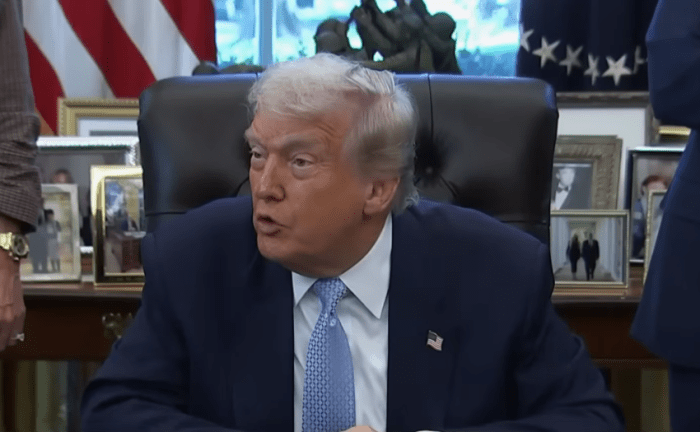President Donald Trump said Monday that Americans could begin receiving $2,000 “tariff dividend” checks as early as the middle of 2026 — marking the clearest timeline yet for a proposal he has floated several times this year.
Speaking from the Oval Office, Trump framed the payments as direct relief for Americans feeling squeezed by rising prices, saying the plan would send “thousands of dollars” to working- and middle-class individuals. He emphasized that the payouts would come from tariff revenues collected under his trade policies.

The official portrait of President Donald Trump, Photo Credit: Based Tom/X
But despite the confident timetable, one major obstacle remains: the plan cannot move forward without congressional approval. Treasury Secretary Scott Bessent made that clear over the weekend, warning that lawmakers would need to pass legislation before any checks could go out. Whether Capitol Hill has the appetite for such a massive new program is still unknown.
A Price Tag That Could Dwarf Existing Tariff Revenue
Early estimates suggest the cost could soar well past $200 billion if the dividends go to individual Americans rather than households — even with income limits attached. That figure would exceed what the government brought in from tariffs in fiscal year 2025 and amounts to roughly half of what officials expect to collect in fiscal 2026.
In other words, the checks would require either a dramatic surge in tariff revenue, additional borrowing, or significant offsets elsewhere in the budget.

President Donald Trump playing with his grandson at the White House, Photo Credit: The White House/X
The Supreme Court Looms Over Trump’s Tariff Blueprint
The timing of Trump’s announcement isn’t accidental. The Supreme Court is expected to rule in the coming months on whether his tariffs — particularly the broader national security tariffs — were legally implemented. That ruling could reshape or even unravel parts of his trade agenda.
Trump has been increasingly vocal about what he sees as the high stakes. In recent remarks, he warned that an unfavorable ruling could force the government to return “up to $3 trillion” in refunds while discouraging future investment tied to American manufacturing.
Framing the issue around a dividend check helps the administration cast the dispute as a direct fight over benefits that ordinary Americans stand to lose.

President Donald Trump talking about the tariff dividend checks in the oval office, Photo Credit: MS Now/Youtube
Political Stakes: Massive Checks, Major Election Year
If the program launches on Trump’s proposed schedule, voters would receive sizable checks just months before the pivotal 2026 midterm elections. Such a windfall would be one of the largest pre-election cash distributions in American history and could dramatically influence voter sentiment.
But economists note a potential downside: flooding the economy with hundreds of billions of dollars could reignite the very inflation the administration insists it has under control. Previous stimulus rounds under both parties triggered rapid price jumps — something the administration says it has learned from as it works to bring down costs across housing, energy, and groceries.

President Donald Trump talking about the tariff dividend checks in the oval office, Photo Credit: MS Now/Youtube
For now, the White House is projecting confidence, stressing that inflation is cooling and will ease further next year. Still, until Congress weighs in, the proposed dividend remains just that — a proposal, not a guarantee.





